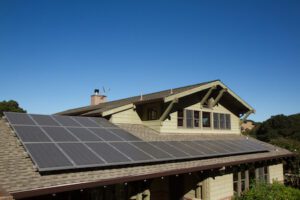
Breaking Down the True Cost of Solar vs. Your Electric Bill
If you’re like most homeowners weighing the idea of switching to solar, you’ve probably asked the big question: “Will this really save me money in the long run?” After 14 years in the solar energy business here in Arizona, I can tell you that solar savings aren’t a gimmick—they’re real. But understanding how those savings stack up against your current electric bill takes a little unpacking.
Let’s walk through what you’re really paying for each month, what a solar setup might cost, and how the numbers shake out when you put the two side by side.
What’s Actually on Your Electric Bill?
When most people look at their electric bill, they think they’re just paying for the power they use. But there’s more buried in those numbers. Your bill includes utility usage, yes—but also delivery charges, service fees, peak-hour pricing, and sometimes regional adjustments. It’s not uncommon to see seasonal spikes in the summer or winter, especially in states like Arizona, where cooling costs can push monthly bills well over $250.
The problem? You’re paying that amount every month, year after year. And utility rates tend to increase over time, which means your cost of doing nothing will only rise.

What Solar Installation Really Costs
There’s a common misconception that solar panels are too expensive for the average homeowner. But solar costs have dropped significantly in the past decade, and federal incentives have made the switch more financially accessible.
Today, a residential solar system typically ranges from $15,000 to $25,000 before incentives. With the 30% federal tax credit, that cost drops to somewhere between $10,000 and $18,000. Many homeowners don’t pay this amount all at once. Instead, they opt for solar loans that replace their electric bill with a monthly payment—often lower than what they were already paying.
Side-by-Side Comparison: Monthly Bills vs. Solar Loans
Let’s say you’re currently paying $250 each month to your utility company. With a financed solar system, your loan payment might land closer to $160 or $180. Meanwhile, your new electric bill—now dramatically reduced—could be as low as $10 to $20. The moment your solar system goes live, you’re spending less each month.
Over time, this adds up to real savings, especially when you consider that your monthly solar loan payment will eventually end—unlike your electric bill, which never stops.
What Happens Once the System is Paid Off?
This is where solar starts to shine—literally and financially. Once your loan term ends, the system is yours. Your panels keep producing energy, often for another decade or two. That means your electricity is essentially free, aside from a few small utility connection fees.
For most homeowners, this results in thousands of dollars saved over the lifespan of the system. And because solar panels are durable and require minimal maintenance, you’re not constantly spending to keep them running.

Do Solar Panels Increase Home Value?
Yes, they often do. Homes with solar systems tend to sell faster and for more money. Buyers appreciate the lower utility costs and long-term energy independence. On average, a home with solar can see a 4–7% increase in resale value, which may even offset the entire cost of the system.
In markets with high electricity costs, that increase in home value is even more pronounced. So if you’re planning to sell in the next 10 years, solar could be a smart investment both now and down the road.
Ongoing Costs and Maintenance Expectations
Unlike HVAC systems or appliances, solar panels don’t need much attention. Most systems are built to last 25 years or more and include warranties that cover performance and manufacturing issues. The most common long-term cost is inverter replacement, which usually happens after 10–15 years and can run around $1,000–$2,000.
Cleaning is another small consideration. If you live in a dusty climate, washing your panels once or twice a year can keep them operating efficiently. But for the most part, solar is a low-maintenance investment.
What Determines How Much You Save?
Every home is different, and your exact savings will depend on several variables. Your current energy usage, the direction and condition of your roof, and your local utility’s net metering policy all play a role.
Homes in sunny states with high energy rates—like Arizona, Nevada, or California—usually see the biggest savings. But even in cloudier regions, solar can still make financial sense with the right system design and incentives in place.

When Is Solar Not a Good Fit?
In all honesty, solar doesn’t make sense for every single home. If your roof is heavily shaded, too small, or near the end of its life, the return on investment might not be strong. Also, if your electricity bills are already extremely low, your break-even point could be farther out than most homeowners are comfortable with.
That said, the majority of homes in the U.S. are viable candidates—and thanks to financing options and performance guarantees, the financial risk is lower than it’s ever been.
It’s About Control, Not Just Savings
At the end of the day, solar isn’t just about trimming your monthly bills. It’s about control. When you install solar panels, you’re taking a step toward independence from fluctuating utility rates and long-term energy costs. You’re turning a variable monthly expense into a stable, predictable investment in your home.
Whether you plan to stay in your house for five years or the next 30, solar puts you in the driver’s seat.
Final Thoughts
Solar energy is one of the few home improvements that pays you back—and continues to do so year after year. While the upfront numbers might feel intimidating, the reality is that most homeowners end up saving money in the first year. And by year five or six, many are ahead by thousands.
If you’re serious about lowering your electric bill, building home equity, and gaining long-term energy stability, solar is well worth exploring.
About the Author
Mark Ellington is a home improvement expert and CEO of a $50M remodeling firm. With 20+ years of experience and a degree in Construction Management from Purdue, he shares practical renovation tips, pricing insights, and contractor advice at 5Estimates.com to help homeowners make smart, informed decisions on their projects.

Leave a Reply